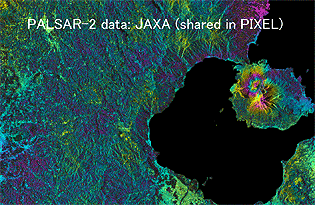A number of Summer Schools were held around the country during the summer of 2015. Students belonging to the University of Aizu's ARC-Space participated in Summer Schools, expand their knowledge alongside participants from all over Japan. This summer, three undergraduates participated in the Summer Schools organized by the Geodetic Society of Japan and the National Astronomical Observatory of Japan's Graduate University for Advanced Studies (SOKENDAI).
1. The Geodetic Society of Japan 2015 Geodesy Summer School
Participants: Daiki Muto (4th-year undergrad), Kana Abe (3rd-year undergrad)
Period: Friday, September 4 to Sunday, September 6, 2015
Content/Impressions: By participating in the Geodesy Summer School, we were able to gain hands-on experience in cutting-edge Interference SAR (synthetic aperture radar) analysis, which lately has attracted a lot attention in the field of volcanic activity monitoring. Since we both had very little knowledge of geodesy, and most of the participants were graduate students or above, we were worried whether we would be able to comprehend the content, despite our efforts to prepare ahead of time. That said, the lecturers gave us in-depth personal instruction on everything from the fundamentals to practical application, allowing us to master the basics of analysis. (*)
In the future, we would like to play a role in environmental monitoring in Fukushima Prefecture while also applying our newly-gained knowledge in our graduate thesis research. Our exchanges with the other participants served as great stimulation. We would like to express our gratitude to all of them, as well as our lecturers.
2. National Astronomical Observatory of Japan Graduate University for Advanced Studies (SOKENDAI) Summer Student Program
Participants: Ryosuke Fujii (3rd-year undergrad)
Period: Tuesday, August 18 to Friday, September 4, 2015
Content/Impressions: I applied to a program that had to do with geomorphic analysis of Jupiter's moon Ganymede and was selected. I engaged in research at the National Astronomical Observatory of Japan's Mitaka campus and Mizusawa observatory, staying there for about half a month. (Click on (5) to see a detailed report.)
- * Here is an example of Muto's analysis of crustal movement in Sakurajima, Kagoshima Prefecture (using the "RINC" software developed by Professor Ozawa of the National Research Institute for Earth Science and Disaster Prevention)



